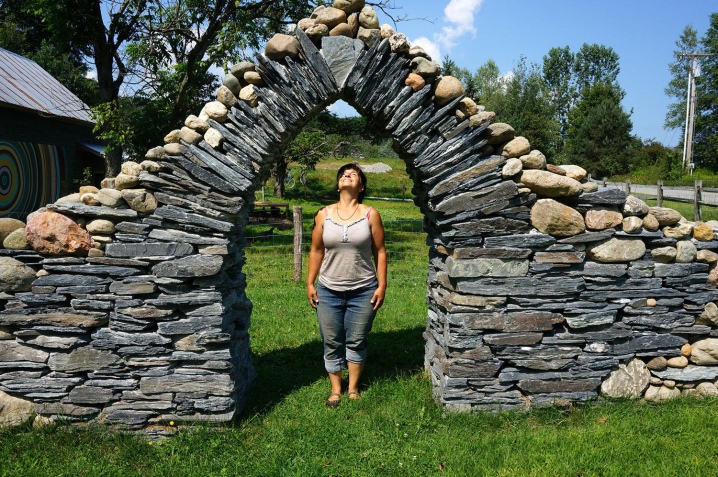What is a keystone and what is it like?

The article will focus on the stone located at the head of the arch. We will tell you what functions it performs, what it looks like and where it is used in architecture.
It turns out that the keystone is not only important, but also beautiful, effectively decorates even unsightly buildings, emphasizes the spirit of the era in which it was entrusted.

Peculiarities
"Keystone" is not the only designation for a part of the arched masonry; builders call it "riveted stone", "lock" or "key". In the Middle Ages, Europeans called the stone "agraph" (translated as "clamp", "paper clip"). All terms indicate the important purpose of this element.
The keystone is located at the top of the arched vault. It resembles a wedge or has a more complex shape, which is noticeably different from the rest of the masonry elements.

The arch begins to be erected from the two lower ends, when it rises to the highest point, it becomes necessary to connect the opposite half-arches. To reliably close them, you need a strong, properly fitted "lock" in the form of an unusual stone, which will create a lateral strut and make the structure as strong as possible. Architects of the past attached special importance to the "castle", distinguished it from all the masonry, decorated it with drawings, stucco moldings, and sculptural images of people and animals.
They came up with a non-standard laying of the castle part of the Etruscan vault, the builders of Ancient Rome took up the successful idea. Much later, the architectural technique migrated to European countries, improving the arched openings of buildings.
Today, having modern technical capabilities, it is not difficult to create a "castle" with elements of spectacular decor. Therefore, the decoration of the "locking" stone is still relevant today.

Species overview
Castle elements are divided by purpose, size, material, shape, decorative variety.
By appointment
Arches are a common technique used in architecture and interior design. The types of "locks" classified by purpose are determined by the location of the arched structure:
- window - the stone can connect the window frame from the outside and inside of the building;
- door - "key" crowns the top of the rounded opening. doors can be entrance or interior;
- independent - located on free-standing arches: garden, park or located in city squares;
- interior - they decorate arched openings between rooms or are decorative vaults of ceilings.


By size
Traditionally, locking elements are divided into 3 types:
- large - facade stones, actively protruding above the pediment of the house, they are immediately noticeable by their grandeur when looking at the building;
- medium - have a more modest size, but stand out from the rest of the masonry;
- small - it is difficult to distinguish them from the wedge-shaped bricks that make up the arched opening.



By form
According to the geometric shape, there are 2 types of riveted stones:
- single - represents a single central wedge-shaped stone at the head of the arch;
- triple - consists of 3 blocks or stones: a large central part and two smaller elements on the sides.


By material
If the "key" plays an important functional role, distributes the pressure of the arched masonry, it is made from the material participating in the overall construction. It can be stone, brick, concrete, limestone.
Decorative keystone is made of any material suitable for the style - wood, onyx, gypsum, polyurethane.


By decorative elements
Often a wedge-shaped lock has no decor. But if an architect decides to decorate the top point of an arched vault, he resorts to different techniques - relief acanthus, sculptural figures of people and animals (mascarons), images of coats of arms or monograms.


Examples in architecture
The agraphs came to Russian architecture from European countries. During the construction of St. Petersburg, the method of closing arches with "keys" was used everywhere, but these were simple wedge-shaped stones, adjusted to the size of the connecting hole. Only with the accession to the throne of Elizabeth Petrovna, the keystone began to take on various decorative forms.
A selection of examples of the use of arched "castles" in architecture will help you understand this topic. Let's start with an overview of the vaults for various purposes, crowned with acanthus:
- the arched bridge between the buildings is decorated with a sculpture of a medieval warrior in armor;

- examples of landscape design using a "key" in the construction of arches from wild stone;


- "Lock" over the window;

- mascarons above the door;


- complex double arch with two decorative "keys";

- arched passages of buildings, crowned with "castles" (in the first case - a simple one, in the second - a mascaron with the image of horse heads).


Consider examples of historical architecture featuring keystones:
- the triumphal arch of Carrousel in Paris;

- Arch of Constantine in Rome;

- a building on Palace Square in Moscow;

- the apartment building of Ratkov-Rozhnov with a giant arch;

- cupids on the arches of Pchelkin's house;

- arch in Barcelona;

- Arch of Peace in Sempione Park in Milan.

The keystone crowning the vaults has become firmly established in the architecture of various nations. It only benefited from the appearance of modern materials in its diversity.














The comment was sent successfully.